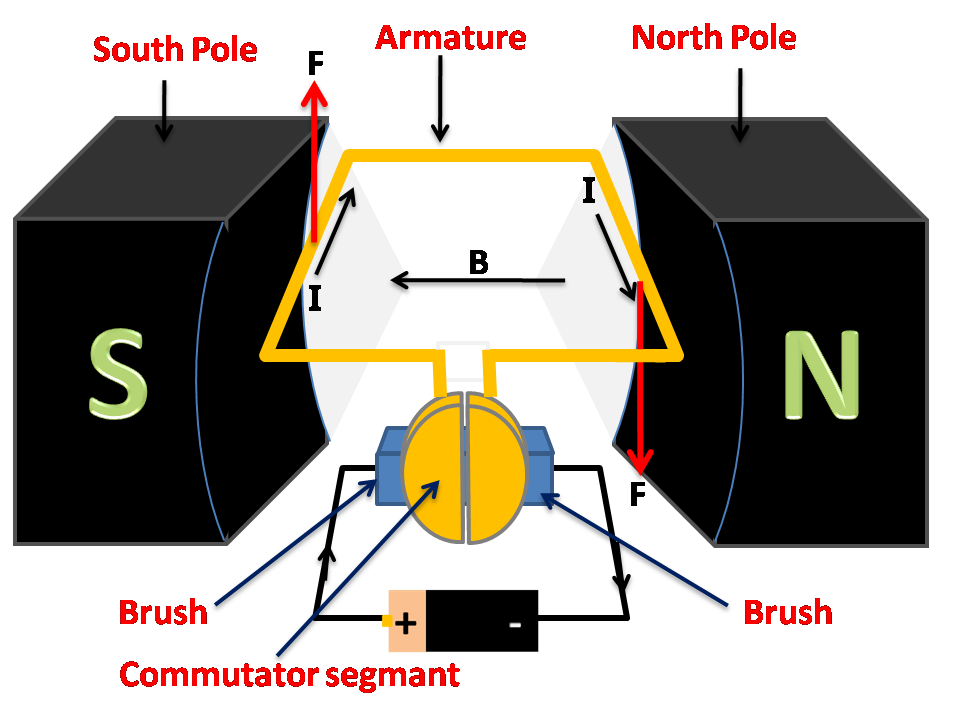
Define electric motor and its working.
Answer
480.6k+ views
Hint:You can reach a solution to this problem by recalling what an electric motor is, it is a device that converts electrical energy into mechanical energy through the concept of electromagnetism. Such electric motors are very popular and vastly used in various things.
Complete step by step answer:
An electric motor is an electrical machine which converts electrical energy into mechanical energy using the concept of electromagnetism. Most electric motors operate through the interaction between the motor's magnetic field and electric current in a rectangular coil to generate force (in the form of torque) on the motor's shaft. These motors can be powered by direct current (DC) sources, such as from batteries, motor vehicles or rectifiers, or by alternating current (AC) sources, such as a power grid, inverters or electrical generators.
Let us have a look at parts of a simple electric motor:
Power Source: A simple electric motor generally has a direct current (DC) power source. It supplies power to the motor armature (or field) coils.

Commutator: It is the rotating interface of the armature coil with a stationary circuit.
Field Magnet: This is one of the most important parts of construction of electric motors. The magnetic field provided by these magnets cause the force (or torque) to be applied on the rectangular coil.
Armature Core: It holds the armature coil in place and provides mechanical support.
Armature Coil: It helps the motor to function and run.
Brushes: A device which conducts current between stationary wires and moving parts of the electric motor.
Working of a simple electric motor:
When electric current is passed into the rectangular coil, this current produces a magnetic field around the coil. The magnetic field of horseshoe-type magnet then interacts with the magnetic field of the coil and causes the coil to rotate continuously. If the rectangular coil is in a horizontal position, the current enters the coil through brushes and the commutator half ring. The current and magnetic field of the horse-shoe magnet interacts and the sides of the coil experience some force due to electromagnetism and start to move. Once the coil is in a vertical position, it experiences no electromagnetic force, but the momentum causes it to further move, and then, as it tipples off from the vertical position, it starts to experience the electromagnetic force and thus, manages to continue the motion.
Note:It is important to never confuse electric motors with electric generators. Although both are very similar, an electric motor converts electrical energy into mechanical energy, while an electric generator converts mechanical energy into electrical energy.
Complete step by step answer:
An electric motor is an electrical machine which converts electrical energy into mechanical energy using the concept of electromagnetism. Most electric motors operate through the interaction between the motor's magnetic field and electric current in a rectangular coil to generate force (in the form of torque) on the motor's shaft. These motors can be powered by direct current (DC) sources, such as from batteries, motor vehicles or rectifiers, or by alternating current (AC) sources, such as a power grid, inverters or electrical generators.
Let us have a look at parts of a simple electric motor:
Power Source: A simple electric motor generally has a direct current (DC) power source. It supplies power to the motor armature (or field) coils.

Commutator: It is the rotating interface of the armature coil with a stationary circuit.
Field Magnet: This is one of the most important parts of construction of electric motors. The magnetic field provided by these magnets cause the force (or torque) to be applied on the rectangular coil.
Armature Core: It holds the armature coil in place and provides mechanical support.
Armature Coil: It helps the motor to function and run.
Brushes: A device which conducts current between stationary wires and moving parts of the electric motor.
Working of a simple electric motor:
When electric current is passed into the rectangular coil, this current produces a magnetic field around the coil. The magnetic field of horseshoe-type magnet then interacts with the magnetic field of the coil and causes the coil to rotate continuously. If the rectangular coil is in a horizontal position, the current enters the coil through brushes and the commutator half ring. The current and magnetic field of the horse-shoe magnet interacts and the sides of the coil experience some force due to electromagnetism and start to move. Once the coil is in a vertical position, it experiences no electromagnetic force, but the momentum causes it to further move, and then, as it tipples off from the vertical position, it starts to experience the electromagnetic force and thus, manages to continue the motion.
Note:It is important to never confuse electric motors with electric generators. Although both are very similar, an electric motor converts electrical energy into mechanical energy, while an electric generator converts mechanical energy into electrical energy.
Latest Vedantu courses for you
Grade 11 Science PCM | CBSE | SCHOOL | English
CBSE (2025-26)
School Full course for CBSE students
₹41,848 per year
Recently Updated Pages
Master Class 12 Economics: Engaging Questions & Answers for Success

Master Class 12 Maths: Engaging Questions & Answers for Success

Master Class 12 Biology: Engaging Questions & Answers for Success

Master Class 12 Physics: Engaging Questions & Answers for Success

Master Class 4 Maths: Engaging Questions & Answers for Success

Master Class 4 English: Engaging Questions & Answers for Success

Trending doubts
Give 10 examples of unisexual and bisexual flowers

Draw a labelled sketch of the human eye class 12 physics CBSE

a Tabulate the differences in the characteristics of class 12 chemistry CBSE

Differentiate between homogeneous and heterogeneous class 12 chemistry CBSE

Why is the cell called the structural and functional class 12 biology CBSE

Differentiate between insitu conservation and exsitu class 12 biology CBSE




